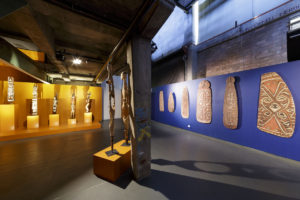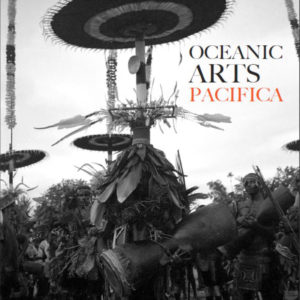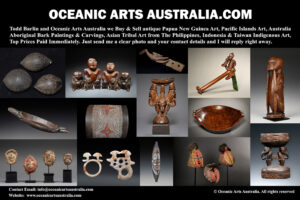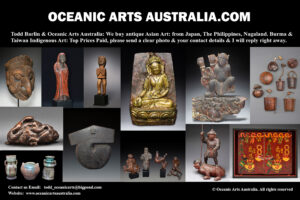A Rare Old New Guinea Slave Hand-Blocks Geelvink Bay Area West Papua Indonesia 19th C
| Collection No. | TB-2741 |
|---|---|
| Size | Length 45cm |
A Rare Old New Guinea Slave Hand-Blocks Geelvink Bay Area West Papua Indonesia from the 19th Century
This is a very rare type of 19th Century cultural object from the Geelvink Bay area on the Northwest Coast of West Papua Irian Jaya Indonesia. A Slaves Hand-Blocks from the 19th Century, made in the form of a Crocodile. There is an important early paper written about these objects by J.M. Hondius 1932 English Translation” Why did the Noemfor Island People make their Slave Blocks in the form of Crocodiles “. In the Publication Cultureel Indie 1932. See in my photos about some examples of these Slave Blocks in the Dutch Museums. Later I will put a link to this interesting article about these rare objects that were used during the 19th Century.
Geelvink Bay & the Islands close by are famous for their Korwar Ancestor Figures Sculptures, these powerful small sculptures are only part of the creative artworks made by these people, Canoe Ornaments, Headrests & other utilitarian objects were often decorated with Korwar Figures & stylised Crocodile figures. ( see my superb Geelvink Bay Adze with Crocodile Head).
I only had part of the 1932 article about the Slaves Hand Blocks translated roughly from Dutch to English which I will add later to this listing.
The Crocodile is an important totemic spirit animal throughout much of the entire Island of New Guinea. The crocodile is part of the ancient creation mythology for many New Guinea tribes. Crocodiles play a central role in the art and culture of the Sepik River people. According to one of the Iatmul people’s Middle Sepik creation mythology, an ancestral crocodile was responsible for forming the land. In the beginning, the earth was covered by a primordial ocean, into whose depths the crocodile dived. Reaching the bottom, it brought up on its back a load of mud, which became an island when it surfaced. From that island, the land grew and hardened, but it continues to rest on the back of the ancestral crocodile, which occasionally moves, causing earthquakes. Even today initiated Sepik Men have body scarification on their back, and chest shoulders to resemble crocodiles.
Provenance: The John & Marcia Friede Collection of New Guinea Art also known as The Jolika Collection most of which is now in The De Young Fine Art Museum in San Francisco California
The Todd Barlin Collection of Oceanic & New Guinea Arts & Arts of West Papua Indonesia
I first went to Papua New Guinea in 1985 for an adventure & what I found was that I really enjoyed being with the people of New Guinea, over the next 38 years I spent extensive time spent collecting and documenting traditional art & ceremonies in remote areas of Papua New Guinea & West Papua, The Solomon Islands & Vanuatu & the other Pacific Islands countries. During these travels, I made major collections of New Guinea & Oceanic Art for major Museums and Public Art Galleries
I was honored by being in the prestigious Louvre Museum Magazine for the collections I made for The Museum of African & Oceanic Art Paris in1996 (now the Musee Quai Branly) for the exhibition “Asmat et Mimika d’ Irian Jaya April 1996 At THE MUSEE NATIONAL des ARTS D’AFRIQUE et d’ OCEANIE, Paris
See all of the links & photos in my new EXHIBITIONS GALLERY and there is the link to the article in the prestigious Louvre Magazine 1996
I have artwork for Museums & Art Galleries but also for collectors at every stage of their collecting. I want to encourage people to explore the fine art of New Guinea & West Papua and the Pacific Islands and to be able to see and touch the artworks in a relaxed and friendly manner in my Sydney Gallery. I would like to invite you to visit my gallery and see the artworks in person and also look at my website www.oceanicartsaustralia.com where there are many Galleries & Sub Galleries to explore.
My Gallery of nearly 40 years is the last physical gallery in Sydney that specializes in New Guinea & Oceanic Art. Sydney is just a couple hours’ flight to New Guinea & the Pacific Islands where all of these amazing artworks came from, Australia’s closest neighbors.
INQUIRE HERE
To see many more rare items and the finest masterpieces, please make an appointment with us to visit the gallery.
For all inquiries, please contact us.















